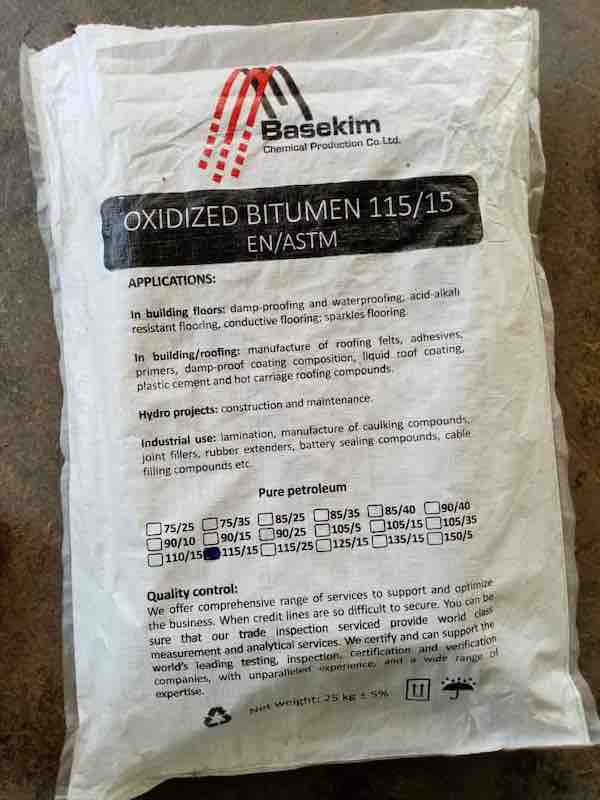
Our bitumen 115/15 is oxidized grade of bitumen with softening point between 110 to 120 centigrade and penetration between 10 to 20 0. millimeter. It is categorizing in oxidized bitumen also known as blown bitumen, is a type of bitumen that has been air-blown or chemically treated to make it more viscous and less volatile.
This process of oxidation increases the molecular weight and softening point of the bitumen, making it more resistant to temperature changes, water, and UV rays. Oxidized bitumen is commonly use in a variety of industrial applications, such as roofing, insulation, and waterproofing, as well as in the manufacturing of paints, varnishes, and adhesives. The degree of oxidation can be controlled to produce different grades of oxidize bitumen, each with different physical and chemical properties suitable for specific applications.
We are exporting premium quality of bitumen 115/15 and removing the solvent and light material from the bitumen and remain the high carbon content material. We add catalyzer to bitumen tower and speed up the production with less oxidization and high polymerization. So we deliver bitumen to customer with more useful material and keep molecular boundary.
This is happen in continues production and close adiabatic media. So we will have less lost and higher quality and price is less compare other way. Our investment for this machinery is 10 times higher than second grade. We have fast delivery and good price.
Price of premium grade is approx. equal to 30% higher than price of fuel oil and depend on packing and customer requirement fluctuating.
Size of packing should be small since it is hard bitumen too difficultly to melt it in big size and normally supplying in 25 kg.
Available packing is:
It is packing on the pallet and 22.8 tons load in 20ft container and must be stuffed on the pallet otherwise the cartons will torn. Inside of carton is none-stickable sheet and should be removed before melting.
The other packing in the cartons is plastic bag and after you take from carton can directly put it in your melting pot.
It is possible to load on pallet or shipping lose packing. While it is on pallet 20 tons can load and while it is lose packing can load 22 tons per 20ft. Inside of this PP bag could be plastic bag with direct use or craft bag with none stickable sheet.
It is most expensive packing since there is mold on and with same mold we can ship out. The mold is carton and at destination you can remove the mold easily.
It is heat resistance bag and filling directly in water to cool down fast. It is firstly use not possible to take out the Polyamide from the bitumen and then use.
Craft bag is recycle packing and inside is special material to prevent sticking the bitumen to bag. This grade also possible to load on pallet or without pallet for customer.
Do not recommend put we have possibility to pack it in drum as well.
Our production line able to produce 200 tons daily but depend on desire packing our export capacity will change. Bitumen 115/15 is too hot and at 190 centigrade discharging to packing and then 1 days take time to cool down then we can palletize and export it.
This hard grade of Bitumen mostly using in pipe coating material, paint, ink and waterproofing and shingle factories. High thermal properties and viscosity plus boundary with other material is main specification of this bitumen.
Sample of oxidize Bitumen 115/15 is available freely for your evaluation and just need to book it via your own courier. It is not DG or flammable and ship it as normal cargo. After sample confirm we will consider the courier charges as discount of cargo to our customer.
To order bitumen 115/15 we need to know
Order quantity
Destination
Packing
Your desire Payment term
On time delivery
Reasonable price
Guaranty quality and inspection before shipment Manufacturer of bitumen 115/15 in various packing and marking. We are doing OEM for customer and fill in customer design packing.
Banking facility.
Office near our customer in Turkey, Hong Kong, Dubai, Montreal, Beijing and Kulalampour.
| BITUMEN 115/15 | SPECIFICATION | TEST METHOD ASTM/EN13304 |
| SPECIFIC GRAVITY @ 25/25 CG | 1.06 | D-70 |
| PENETRATION @ 25 C | 10 to 20 | D-5 |
| SOFTENING POINT C | 110 to 120 | D-36 |
| LOSS ON HEATING(WT) % | 0.1 | D-6 |
| FLASH POINT C | 340 | D-92 |
| SOLUBILITY IS CS2(WT) % | 99.5 | D-4 |
| DUCTILITY @ 25 °C | 1.9 | 1.5 CM MIN |
| SATURATES (ASTM D2007) | 6% | D2007 |
| ASPHALTENES (IP 143) | 37% | IP 143 |
| RESINS | 28% | D2007 |
| AROMATICS | 30% | D2007 |
Bitumen 115/15 is widely used for roofing felt, waterproofing membranes, and industrial protective coatings. Moreover, its hardness and high softening point make it ideal for hot climates and demanding construction environments.
We supply Bitumen 115/15 in carton boxes, meltable poly bags, and jumbo bags. Consequently, these packaging options ensure safe handling, clean storage, and easy melting at the project site.
Basekim guarantees strict quality control, flexible packaging solutions, and global shipping services. Therefore, you receive a reliable product that meets international standards for industrial and construction applications.